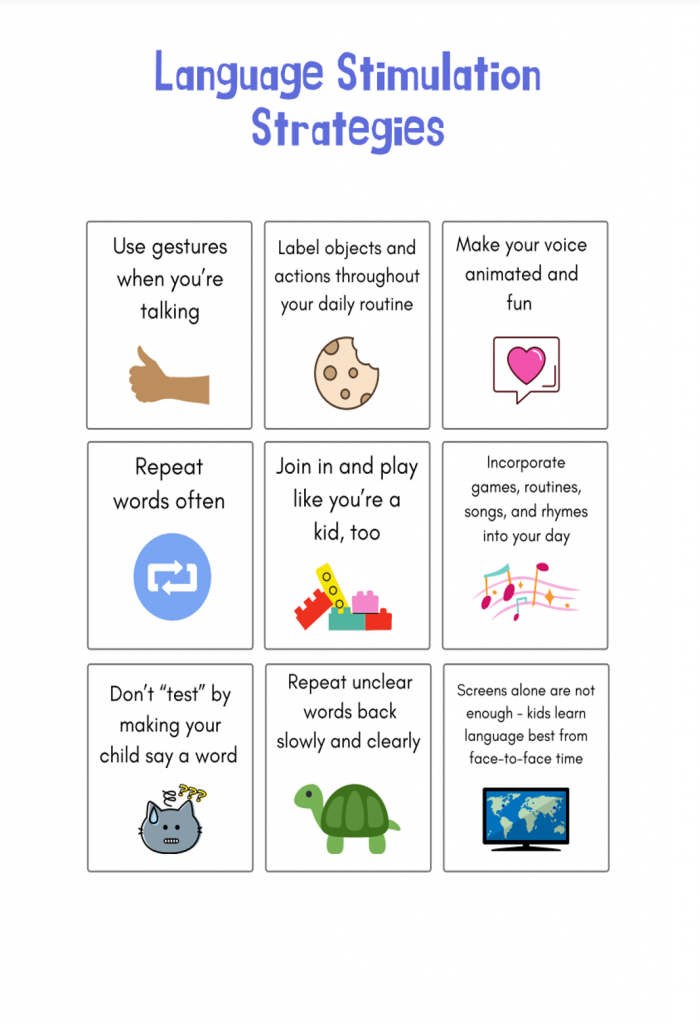How parents/ carers and childcare educators can develop the speech and language skills of toddlers.
Parents, carers, and childcare educators can develop and expand the speech and language skills of toddlers through language stimulation. Language stimulation is a set of interaction strategies that can be used in any context. These strategies can be used in everyday situations, storytelling, reading/ writing, during discussions and performing arts experiences.
Strategies include:
Self-talk/ Parallel Talk
- Stimulating language development by modelling the language used during your interaction with your toddler. Parents/ carers and educators can talk about
- What they’re doing (self-talk)
- What the child is doing (Parallel talk).
| Self-Talk Examples | Parallel Talk Examples |
| The educator describes and comments on what he/she is doing. Language is provided to describe one’s own actions, when interacting and playing alongside children.· e.g. “I’m sitting down next to Ahmed. I want to see what Ahmed is doing with his play dough.”· e.g. “Look at all of this tasty fruit! I’m going to choose watermelon. I love watermelon. It’s my favourite fruit!” | The educator commentates or narrates what a child is doing· Language is provided to describe the child’s actions· Educators/carers use purposeful pauses, eye contact and gestures to allow children opportunities to communicate with words, sounds or gestures· Educator: “You’re building a tower! You’ve got the blue block, and it’s going on the long red block. [pause] What is coming next? [pause] Now you’ve found the biggest green block! |
Expansion
This is best used for young toddlers who are starting to use their first words. Expansion is a great way to model how to combine words into phrases and sentences through the words the toddler is already saying in context. This strategy can also help interactions going as it allows the toddler to know you are listening and that you understand them. When a young toddler uses a word or two words, the parent/ carer or educator expands on the words to make a short phrase. Examples are as follows.
- Child says “drink”, the parent/ educator would reply “drink water” or “dog is drinking”
- Child says “up”, the parent/ educator would reply “Let me up please!” or “Let’s go up”.
Extension
- This is useful for children who can combine some words together. Parents/ educators can use extension to show toddlers how to add more information into their language. It can also model how to communicate messages using a variety of different sentences. Examples are as follows;
- Child says, “dog drink”, the parent/ educator would reply “the dog is thirsty”
- Child says, “car go”, the parent/ educator would reply “It is a red car” or “The fast car is going”.
Examples of activities to foster language stimulation includes:
- Play-dough
The goals are simply to:
- Encourage free exploration of the materials, which encourages creativity.
- Expand their ability to pretend and imagine
- Help them learn some interesting new words that label their interests and actions.
- Building Blocks
Building towers and similar structures isn’t just a fun game to play; it also provides ample opportunity to work on language skills. You can introduce adjectives like “higher” and “up”, verbs such as “build” and “fall down,” as well as numbers and colours.
- Puppets
Give your child toys or puppets and encourage him to have conversations with them. Kids are creative and imaginative – once you show them the way, they will take over. You can also use puppets to have simple conversations with your child. Put on a puppet show to make playtime more enjoyable.


